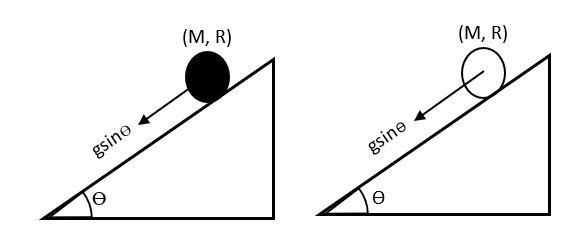
A solid cylinder and a hollow cylinder, both of the same mass and same external diameter are released from the same height at the same time on an inclined plane. Both roll down without slipping, which one will reach the bottom first?
A. Both together only when angle of incidence of plane is $45^{\circ}$
B. Both together
C. Hollow cylinder
D. Solid cylinder
Answer
485.1k+ views
Hint: We will first find out the moment of inertia of both the cylinders and then will use the formula of acceleration of an object rolling down an inclined plane without slipping. Then by using the equations of motions, we can find the time for both the cylinders.
Formula used: $a=\dfrac{gsin\theta}{1+\dfrac{I}{MR^2}}$
Complete step by step answer:

Let us assume the mass of both solid and hollow cylinder by M and their radius be R, both rolling down an inclined plane of length $l$ making angle $\theta$ with the horizontal without slipping.
We know that, acceleration of a purely rolling object along an inclined plane without slipping is given by, $a=\dfrac{gsin\theta}{1+\dfrac{I}{MR^2}}$ ………. (i)
where, $\theta$ is the inclination of the plane, I is the moment of inertia of the object about an axis perpendicular to its cross-section, M is the mass of the object and R is its equivalent radius.
Now, as per the question both cylinders were released from rest. So, using the distance formula from the equations of motion, we get $S=\dfrac{1}{2}at^2$
As the length of inclined plane is $l$ and putting the value of acceleration from equation (i), we get $S=\dfrac{1}{2}\times \left(\dfrac{gsin\theta}{1+\dfrac{I}{MR^2}}\right)t^2$
$\implies t=\sqrt{2l\left(\dfrac{1+\dfrac{I}{MR^2}}{gsin\theta}\right)}$ ………. (ii)
For solid cylinder,
Moment of inertia, ${I}_{s} = \dfrac{MR^2}{2}$
Therefore, time taken by the solid cylinder to reach the bottom of incline using equation (ii),
${t}_{s}=\sqrt{2l\left(\dfrac{1+\dfrac{MR^2 /2}{MR^2}}{gsin\theta}\right)}=\sqrt{\dfrac{3l}{gsin\theta}}$ ………. (iii)
Now, for hollow cylinder,
Moment of inertia, ${I}_{h} = MR^2$
Therefore, time taken by the solid cylinder to reach the bottom of incline using equation (ii),
${t}_{h} =\sqrt{2l\left(\dfrac{1+\dfrac{MR^2}{MR^2}}{gsin\theta}\right)}=\sqrt{\dfrac{4l}{gsin\theta}}$ ………. (iv)
So, clearly from the equations (iii) and (iv), we can say that ${t}_{s}<{t}_{h}$.
Thus, the solid cylinder will reach the bottom first. Hence, the correct answer is option D.
Note:
The formula for time that we derived can also be used directly. But for concept clearance, we derived here the formula. We can also use the conservation of energy at the point of release and at the bottom to find the final velocity of the cylinders, which in turn can give the time required.
Formula used: $a=\dfrac{gsin\theta}{1+\dfrac{I}{MR^2}}$
Complete step by step answer:

Let us assume the mass of both solid and hollow cylinder by M and their radius be R, both rolling down an inclined plane of length $l$ making angle $\theta$ with the horizontal without slipping.
We know that, acceleration of a purely rolling object along an inclined plane without slipping is given by, $a=\dfrac{gsin\theta}{1+\dfrac{I}{MR^2}}$ ………. (i)
where, $\theta$ is the inclination of the plane, I is the moment of inertia of the object about an axis perpendicular to its cross-section, M is the mass of the object and R is its equivalent radius.
Now, as per the question both cylinders were released from rest. So, using the distance formula from the equations of motion, we get $S=\dfrac{1}{2}at^2$
As the length of inclined plane is $l$ and putting the value of acceleration from equation (i), we get $S=\dfrac{1}{2}\times \left(\dfrac{gsin\theta}{1+\dfrac{I}{MR^2}}\right)t^2$
$\implies t=\sqrt{2l\left(\dfrac{1+\dfrac{I}{MR^2}}{gsin\theta}\right)}$ ………. (ii)
For solid cylinder,
Moment of inertia, ${I}_{s} = \dfrac{MR^2}{2}$
Therefore, time taken by the solid cylinder to reach the bottom of incline using equation (ii),
${t}_{s}=\sqrt{2l\left(\dfrac{1+\dfrac{MR^2 /2}{MR^2}}{gsin\theta}\right)}=\sqrt{\dfrac{3l}{gsin\theta}}$ ………. (iii)
Now, for hollow cylinder,
Moment of inertia, ${I}_{h} = MR^2$
Therefore, time taken by the solid cylinder to reach the bottom of incline using equation (ii),
${t}_{h} =\sqrt{2l\left(\dfrac{1+\dfrac{MR^2}{MR^2}}{gsin\theta}\right)}=\sqrt{\dfrac{4l}{gsin\theta}}$ ………. (iv)
So, clearly from the equations (iii) and (iv), we can say that ${t}_{s}<{t}_{h}$.
Thus, the solid cylinder will reach the bottom first. Hence, the correct answer is option D.
Note:
The formula for time that we derived can also be used directly. But for concept clearance, we derived here the formula. We can also use the conservation of energy at the point of release and at the bottom to find the final velocity of the cylinders, which in turn can give the time required.
Recently Updated Pages
Master Class 11 Accountancy: Engaging Questions & Answers for Success

Glucose when reduced with HI and red Phosphorus gives class 11 chemistry CBSE

The highest possible oxidation states of Uranium and class 11 chemistry CBSE

Find the value of x if the mode of the following data class 11 maths CBSE

Which of the following can be used in the Friedel Crafts class 11 chemistry CBSE

A sphere of mass 40 kg is attracted by a second sphere class 11 physics CBSE

Trending doubts
Define least count of vernier callipers How do you class 11 physics CBSE

The combining capacity of an element is known as i class 11 chemistry CBSE

Proton was discovered by A Thomson B Rutherford C Chadwick class 11 chemistry CBSE

Find the image of the point 38 about the line x+3y class 11 maths CBSE

Can anyone list 10 advantages and disadvantages of friction

Distinguish between Mitosis and Meiosis class 11 biology CBSE




